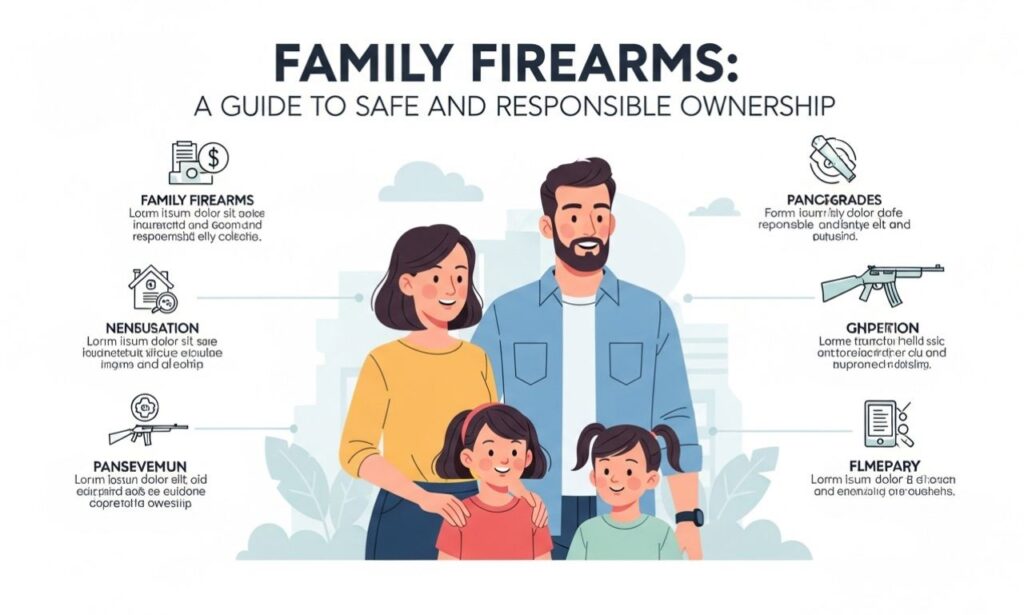When it comes to family life, safety is often at the forefront of our minds. One topic that can evoke strong feelings is firearms. Family firearms are more than just tools for sport or protection; they represent a commitment to responsible ownership and education. As families navigate this complex landscape, understanding how to manage firearms safely becomes crucial. Whether you’re a seasoned owner or considering your first purchase, exploring the principles of safe firearm ownership within a family context can foster security and peace of mind. This guide will delve into what family firearms entail and how you can ensure they contribute positively to your household dynamic while prioritizing safety above all else.
What is Family Firearms?
Family firearms refer to guns owned and used by families for various purposes. These can include hunting, sport shooting, or home defense. The focus is on responsible ownership that prioritizes safety and education.
Families may choose firearms to bond over shared interests like outdoor activities. Teaching skills such as marksmanship fosters teamwork and trust among family members.
Responsible firearm ownership also includes understanding laws and regulations regarding gun use within the household. Each state has unique rules, which makes it essential for families to stay informed.
In addition, family firearms often encompass a commitment to safe practices. This means not only securely storing weapons but also ensuring all members know how to handle them safely if needed.
Benefits of Responsible Firearm Ownership in a Family Setting
Responsible firearm ownership offers numerous benefits for families. It fosters a culture of safety and awareness, essential in any household where firearms are present.
Having firearms at home can enhance personal security. Families often feel more secure knowing they have the means to protect themselves when necessary.
Moreover, responsible ownership promotes trust and communication among family members. Discussing firearms openly can lead to better understanding and cooperative practices regarding their use.
Educational opportunities abound as well. Learning about proper handling teaches valuable life skills that extend beyond gun safety—such as discipline, responsibility, and critical thinking.
It allows families to engage in shared activities together like target shooting or hunting. These experiences can strengthen family bonds while instilling respect for nature and equipment used.
Safety Measures for Families with Children
Safety should be the top priority for families with firearms. Establishing clear rules around guns is essential. Kids need to understand that firearms are not toys.
Locking up your firearms is a must. Use gun safes or lockboxes to ensure that only responsible adults have access. This simple step can prevent tragic accidents and provide peace of mind.
Educating children about firearm safety also plays a vital role. Teach them what to do if they encounter a gun—stop, don’t touch, and tell an adult immediately.
Regularly discussing these topics reinforces their importance. Make it part of family conversations so kids feel comfortable asking questions.
Involving your family in safe practices creates a culture of responsibility around firearm ownership. It’s not just about having guns; it’s about knowing how to handle them safely in every scenario.
Teaching Children About Gun Safety
Teaching children about gun safety is crucial for responsible firearm ownership. Start by introducing the concept of firearms in a calm and clear manner. Use age-appropriate language that helps them understand what guns are and why they should be treated with respect.
Encourage open dialogue. Let them ask questions, express their curiosities, and voice any fears they may have. This creates an environment where safety becomes a shared responsibility.
Demonstrate proper handling techniques through safe practices like never pointing a gun at anyone, even if it’s unloaded. Role-playing scenarios can help reinforce these lessons in an engaging way.
Regularly discuss the importance of telling an adult if they see a firearm lying around or feel uncomfortable around one. Empowering them to speak up fosters accountability and vigilance as part of their understanding of safety protocols.
Proper Storage and Maintenance of Firearms
Proper storage of firearms is crucial for safety and longevity. Always keep guns unloaded when not in use. Store them in a secure location, such as a locked cabinet or safe. This prevents unauthorized access, especially by children.
Temperature and humidity matter too. Firearms should be kept in a cool, dry place to avoid rust and corrosion. Use silica gel packs to maintain the right environment inside your storage unit.
Regular maintenance is essential for optimal performance. Clean your firearm after each use to remove residue that can affect functionality over time. Check all components periodically for wear and tear.
Investing in quality cleaning supplies makes this task easier and more effective. A well-maintained firearm functions better and ensures safety during handling.
Familiarize yourself with the specific care requirements of your firearm model to ensure proper upkeep year-round.
Choosing the Right Firearm for Your Family’s Needs
Choosing the right firearm for your family involves careful consideration. Start by assessing your family’s needs and lifestyle. Are you looking for home defense, recreational shooting, or hunting? Each purpose requires a different type of firearm.
Consider the experience level of everyone in your household. If you’re new to firearms, a user-friendly option like a .22 caliber rifle might be ideal for beginners. It allows practice with manageable recoil.
Don’t forget about size and weight. A lightweight shotgun may suit smaller family members better than a heavier model. Comfort is key when selecting any firearm.
Research various brands and models before making a purchase decision. Reviews from other families can provide insights into reliability and ease of use.
Always involve all stakeholders in discussions about choices. This fosters understanding and responsibility within the family dynamic surrounding firearms.
Resources for Training and Education on Family Firearms
Finding the right resources for training and education on family firearms can make a significant difference in promoting safety and responsibility. Numerous organizations offer courses geared toward families, emphasizing safe handling, storage, and shooting techniques.
The National Rifle Association (NRA) provides various programs tailored to different skill levels. Their Family Firearms Program is particularly beneficial. It introduces families to fundamental firearm knowledge while encouraging safe practices.
Local shooting ranges often host workshops that cover essential topics related to firearm ownership. These hands-on sessions allow family members to experience real-world scenarios under expert supervision.
Online platforms also have extensive educational content, including videos and articles focused on gun safety. Websites dedicated to responsible gun ownership frequently update their materials with current laws and best practices.
Consider joining local hunting or shooting clubs where experienced members share valuable insights about firearm use within the family dynamic. Engaging with these communities fosters deeper understanding and support among like-minded individuals.
Addressing Controversial Topics Surrounding Family Firearms
Family firearms often spark heated debates. Concerns about safety, regulation, and personal rights can make discussions tense.
Gun control is a significant issue in many communities. Opponents argue for stricter laws to prevent accidents and misuse. Supporters believe in the right to own firearms for protection and recreation.
Another topic is the impact of media portrayal on gun ownership. Movies and news can shape perceptions, sometimes skewing reality. Understanding these influences helps families navigate their views on firearms responsibly.
Mental health also plays a crucial role in firearm discussions. Families must consider how mental well-being affects safe ownership practices.
Engaging with differing opinions opens pathways for understanding. Families can learn from each other while fostering an environment of respect around this sensitive subject.
Embracing Safe and Responsible Firearm Ownership in the Home
Creating a culture of safety around family firearms starts with open conversations. Families should discuss the importance of responsible ownership and what that looks like in practice.
Emphasizing respect for firearms is key. Each member must understand that guns are tools requiring careful handling, not toys.
Implementing strict rules about when and where to use a firearm helps maintain safety. Designating specific areas for usage, along with supervised practices, nurtures responsibility.
Regularly reviewing safety protocols can further reinforce these principles. Ensure everyone knows how to react if they encounter a firearm unexpectedly.
Beyond talks and rules, leading by example makes a significant impact. Demonstrate safe behaviors consistently to instill lasting habits within the household.
Embracing this mindset fosters an environment where responsible firearm ownership becomes ingrained in everyday life.
Conclusion
Family firearms can play a significant role in many households, offering both protection and recreational opportunities. However, it’s essential to approach ownership with care and responsibility. Understanding the importance of safety measures, proper education for all family members, and secure storage practices cannot be overstated. By fostering an environment where open discussions about gun safety take place, families can cultivate responsible attitudes toward firearm ownership.
The key lies in finding the right balance between ensuring security and enjoying the benefits that firearms can provide as part of family life. Resources are available for those looking to enhance their knowledge and skills related to firearm safety—utilizing these tools strengthens not only individual confidence but also collective awareness within your home.
As society continues to discuss topics surrounding firearms, embracing safe practices promotes positive experiences while respecting differing opinions. Family firearms should never become just another item on a shelf; they must be treated with respect through continuous learning and proactive engagement among all family members.
Choosing this path leads to a culture of responsibility that benefits everyone involved, protecting what truly matters most: your loved ones.






